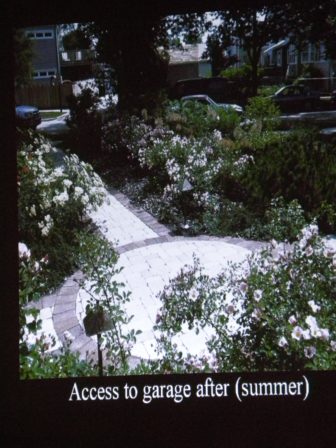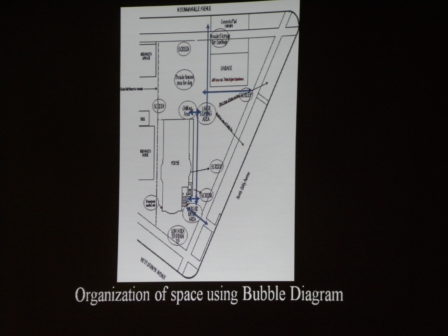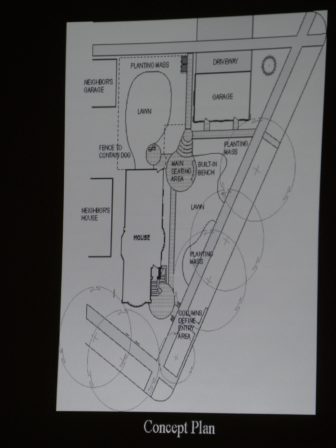Creating a Bungalow Garden
John Beaudry spoke about the Craftsman Bungalow and its complementing garden at the January Mission Hills Garden Club meeting. Beaudry began with an explanation of what the Arts and Crafts Movement was before segueing into the bungalow and garden.
The Arts and Crafts Movement grew from a rebellion against the mechanization of the Industrial Revolution. This rebellion, or social reform movement, continued for almost a century. Its founders felt that the factory system prevented workers from the satisfaction of seeing their work “from conception to completion.” Work, for them, connected both life and nature, thus enriching one’s inner life. This movement grew into the beginnings of modern international design philosophy which influenced social lives, architecture, and crafts themselves.
In its early days, the Arts and Crafts Movement led to creations that only the very wealthy could afford. Even the artisans were unable to buy much of what they created. However, with time, the movement was able to reach a larger audience. Magazines such as William Morris’ magazine, The Craftsman helped bring it to more of the population. John Ruskin’s book, “Stones of Venice,” was another avenue leading to this movement. Ruskin had three rules: A structure should reveal its “true purpose and not be decorative (structural honesty), it should be designed according to “its intended function—that is form follows function (functional honesty), and the materials should be chosen on the basis of “their regionality and character (material honesty).”
The Craftsman bungalow, says John, represents the quintessential arts and crafts era. Although the bungalow originated in India as a single storied building with a verandah wrapping completely around the structure, the English, recognizing its usefulness as a floor plan for a more elegant building, expanded on the original. The verandah became a front porch affording a way to be part of the neighborhood and yet apart from it. Wood was left unpainted to reveal the natural beauty of its grain. Best of all, the magazines such as The Craftsman and The Bungalow as well as the Sears, Roebuck catalog published directions for creating one’s own furniture or bungalow. For $882.00 Sears sold a kit which contained materials and directions for assembling a Craftsman home.
With the growing appreciation of nature in its more “natural” state, gardens changed as well. It was not unusual for plantings to be right against the house providing a view of greenery as well as a screen for privacy when one looked out. William Robinson wrote The Wild Garden which espoused ideas such as allowing plants to spill over their boundaries, planting flowers as they might grow naturally as opposed to the symmetry and formality of Versailles, for example. Beaudry explained that the collaboration of Gertrude Jekyll and Edward Lutyens on over 100 gardens laid the foundation for Arts and Crafts gardens in England.
John laid out what he calls the Guiding Principals of an Arts and Crafts Garden.
1. Unity of house and garden
2. Nature as primary source of inspiration
3. Use of local materials and plants
4. Relaxed plantings
5 Enclosure of the garden and its rooms
6. Integrate the existing landscape
7. Include edible plants
Beaudry explained these principals further using slides showing pergulas coming from the home itself thus unifying the two, specific areas for various activities which are either walled or separated by the landscape. He showed us how a view from one of Morris’ homes which he, Morris, turned into a design for wallpaper. An artificial river and water fall mimicked a local river and its falls, a way to use local materials and plants. Plants are planted as they might grow naturally, and the color palate is chosen to mimic. Other slides showed homes designed to preserve trees that had grown naturally. He also showed us beautiful landscaping created from vegetables, salad greens, and fruit trees and bushes. Paths meander creating a more appealing and welcoming environment.
Beaudry concluded by giving us his design process.
1. Create a base plan
2. Perform a Site Analysis (first rough and then to scale)
3. Create a Bubble Plan
4. Choose a Design Concept
5. Lay out Planting Plan (woody, or structural; herbaceous, or ephemeral)
He illustrated this with slides documenting the Site Evaluation and Client Input. First he showed us photographs of each of the “problem” areas as well as areas for which the clients had specific requests. This was followed by the bubble diagram showing areas labeled with their future purpose. The Concept Plan gave a better sense of how the elements would fit. This appeared to be more to scale. Beaudry included slides showing the work as it was in process. His final slides showed before and after shots of each of the areas that needed attention. The transformation was amazing.
The speaker March 28 will be Bruce Berg to answer the question “How Come my Orchids Die?” Meetings are free for members, $10 for guests, and that $10 can be applied to membership if you decide to join after the meeting that night. Membership is $35 for a single, $50 for family membership (2 adults in the same household). Meetings are usually held at the Mission Hills Church of Christ at 4070 Jackdaw from 6 to 8 p.m. We encourage plant and magazine exchanges.
Category: Life Style










